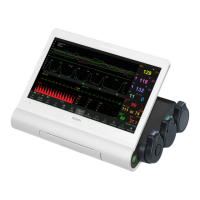F15 Series Fetal & Maternal Monitor User Manual After Monitoring
- 99 -
1 After the monitor is switched on, if electrodes are not well attached or fell off, alarm
message “ECG LEADS OFF” will appear on the screen to draw your attention.
2 Vigorous exercise will interfere with MHR monitoring and computing. Please try to avoid it.
8.1.4 Changing ECG Gain
You can change the ECG gain. The ECG gain affects overall numeric and scope of the ECG
waveform.
1 Select the main menu key on the main interface.
2 Select Mother > Gain.
3 Select X1/4, X1/2, X1 (default), X2 or X4.
‘Auto’ means the monitor adjusts the gain automatically. The system displays a 1mv scale at
the left side of the ECG waveform. The height of 1mv bar is directly proportional to the
waveform amplitude.
4 Select OK.
8.2 Maternal SpO
2
Monitoring
8.2.1 Introduction
The monitor provides continuous monitoring of functional arterial oxygen saturation (SpO
2
) and pulse
rate (PR) for pregnant women.
SpO
2
Plethysmogram measurement is employed to determine the oxygen saturation of hemoglobin in
the arterial blood. If, for example, 97% hemoglobin molecules in the red blood cells of the arterial
blood combine with oxygen, then the blood has a SpO
2
oxygen saturation of 97%. The SpO
2
numeric
on the monitor will read 97% .The SpO
2
numeric shows the percentage of hemoglobin molecules
which have combined with oxygen molecules to form oxyhemoglobin. The SpO
2
/PLETH parameter
can also provide a pulse rate signal and a plethysmogram wave.
SpO
2
Plethysmogram Measurement Principle:
Pulse oximetry is a continuous and noninvasive monitoring technique used to estimate the
measurement of arterial oxygen saturation. It measures the amount of light penetrating the patient
tissue and reaching the receiver. The reading, obtained through pulse oximetry, uses a light sensor
containing two sources of light (red and infrared) that are absorbed by hemoglobin and transmitted
through tissues to a photodetector.
The amount of light penetrated depends on multiple factors and most of them are constant. However,
the arterial blood flow changes with time passing by as is pulsative. The arterial oxygen saturation can
be obtained through testing the absorbed light during pulsation. Plethysmogram wave and pulse rate
signal can be also provided during pulsation testing.
The sensor contains LEDs that emit red light at a wavelength of approximately 660 nm and infrared
light at a wavelength of approximately 900 nm. Information about wavelength range can be especially
useful to clinicians.
The F15 monitor is compatible with the SpO
2
transducers supplied by EDAN only. The SpO
2
transducer manufactured by EDAN can only be used with the F15 monitor. Compatibility should be
checked prior to use. Otherwise the monitor performance can be degraded.
They have been tested and found to comply with the limits for medical device in IEC/EN60601-1-2
(International standard for EMC testing of Medical Electrical Equipment, second edition). These limits
are designed to provide reasonable protection against harmful interference in typical medical
installation.
WARNING
1 Before monitoring, check whether the sensor cable is normal. If any sign of damage in the
SpO
2
sensor is detected, do not use the sensor. Return it to the manufacturer for service.
2 Do not put the SpO
2
sensor on the extremities with arterial catheter or venous syringe.
Traditional 510(k) of Fetal & Maternal Monitor
014_14.1_F15_Series_User_Manual

